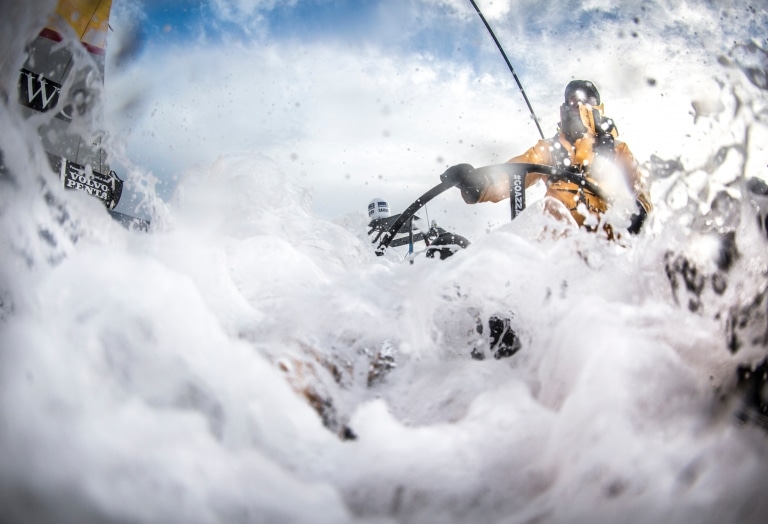Seven ways to survive the Southern Ocean
 March 27,2015. Leg 5 to Itajai onboard Abu Dhabi Ocean Racing. Day 9. Luke \”Parko\” Parkinson helms Azzam through the white foam of the Southern Ocean.
March 27,2015. Leg 5 to Itajai onboard Abu Dhabi Ocean Racing. Day 9. Luke \”Parko\” Parkinson helms Azzam through the white foam of the Southern Ocean.
On Sunday 10 December, the Volvo Ocean Race fleet departs Cape Town and plunges south, into the mysterious Southern Ocean.
With double points up for grabs, it means that Leg 3 could be a game changer in the 2017-18 edition, and makes the risk v reward conundrum in the most remote ocean on the planet even more real than ever before.
Since 1973, the Southern Ocean has been the ultimate testing ground for the world’s best sailors – and with incredibly fast racing, on the edge, it can be both thrilling and dangerous.
It’s going to be an epic and full throttle 6,500 miles, with huge waves, freezing storms, biblical winds and crazy storms.
What’s not to love? Here are seven ways to survive the Southern Ocean…
Hold on tight. The area from around 40°S to the Antarctic Circle has the strongest average winds found anywhere on Earth – and cyclonic storms travel eastward around the continent. The good news for Volvo Ocean Race sailors? That means extremely fast racing.
Come prepared. The water temperature varies from −2 to 10°C around the Antarctic, and in winter, the ocean freezes outward to the 65°S latitude in the Pacific sector. Note to sailors: don’t forget your thermals. And gloves. And a hot water bottle.
Sleep with one eye open. The Southern Ocean is home to vast, pristine icebergs – and with up to 90% of their mass submerged underwater, they really pose a formidable danger for Volvo Ocean Race sailors.
That’s why Race organisers have added and Antarctic Ice Exclusion Zone into the Leg 3 sailing instructions. Despite this, the sailors still have to remain vigilant and on the look out, particularly for the but smaller, drifting growlers, which are harder to spot.
The worst part? When the black of night comes, they still lurk – silently waiting.
Do your research. The colder the air, the denser it is. This makes for harder, more powerful winds in the Southern Ocean. It’s not an easy variable to quantify, but it’s one of the reasons why the Volvo Ocean 65 boats are often faster than their theoretical polar speeds in this part of the world.
Enjoy the surf. A long rolling swell forms as winds blow around the entire globe unimpeded by any land, making for pretty special downwind sailing.
When the boats surf they are faster than the waves, so a steady hand is required on the helm to avoid smashing into the waves ahead. Experience pays and extreme conditions will great big differences in the fleet.
Make friends with your neighbours. There are some curious – and often endangered – creatures in and out of the Southern Ocean waters. The Volvo Ocean Race fleet often receives visits from albatross and whales, amongst other species.
Trust that you’re being looked after. You’re in a very remote place, but you’re in good hands.
Two Maritime Rescue Coordination Centres manage this area: the New Zealand branch when west of the 131°W longitude, and the Chilean office east of it. Volvo Ocean Race HQ in Alicante is in constant contact with them, ensuring the fleet’s safety.
Text by Jonno Turner










